Discover 50 hidden attractions, cool sights, and unusual things to do in Germany. Don't miss out on these must-see attractions: Brandenburg Gate (Berlin), Pergamon Museum (Berlin) or Fernsehturm (Berlin).
Below, you can find the list of the most amazing places you should visit in Germany.
Table of Contents
Brandenburg Gate, Berlin
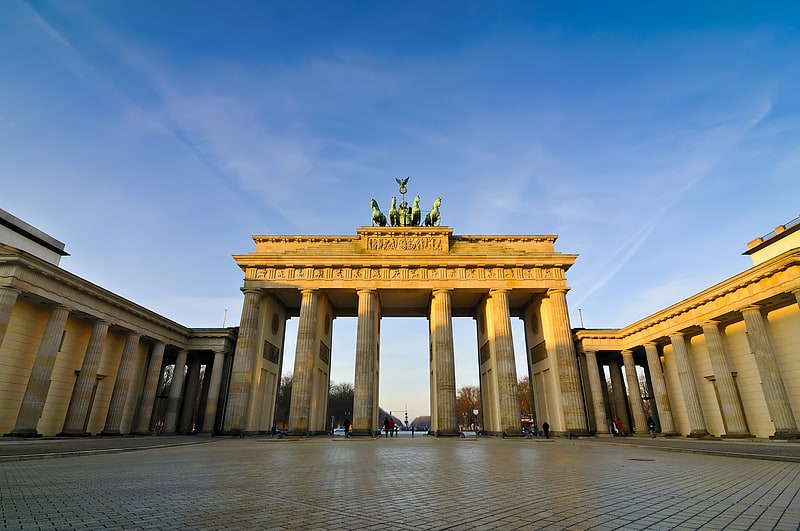
Also known as: Brandenburger Tor
Grand classical archway and city divide. The Brandenburg Gate is an 18th-century neoclassical monument in Berlin, built on the orders of Prussian king Frederick William II after the temporary restoration of order during the Batavian Revolution. One of the best-known landmarks of Germany, it was built on the site of a former city gate that marked the start of the road from Berlin to the town of Brandenburg an der Havel, which used to be the capital of the Margraviate of Brandenburg.
It is located in the western part of the city centre of Berlin within Mitte, at the junction of Unter den Linden and Ebertstraße, immediately west of the Pariser Platz. One block to the north stands the Reichstag building, which houses the German parliament (Bundestag). The gate is the monumental entry to Unter den Linden, a boulevard of linden trees which led directly to the royal City Palace of the Prussian monarchs.
Throughout its existence, the Brandenburg Gate was often a site for major historical events and is today considered not only as a symbol of the tumultuous histories of Germany and Europe, but also of European unity and peace.[1]
Address: Pariser Platz 7, 10117 Berlin (Mitte)
Pergamon Museum, Berlin

Also known as: Pergamonmuseum
Antiquities and ancient art collections. The Pergamon Museum is a listed building on the Museum Island in the historic centre of Berlin, Germany. It was built from 1910 to 1930 by order of Emperor Wilhelm II according to plans by Alfred Messel and Ludwig Hoffmann in Stripped Classicism style. As part of the Museum Island complex, the Pergamon Museum was inscribed on the UNESCO World Heritage List in 1999 because of its architecture and testimony to the evolution of museums as architectural and social phenomena.
Currently, the Pergamon Museum is home to the Antikensammlung including the famous Pergamon Altar, the Vorderasiatisches Museum and the Museum für Islamische Kunst. Parts of the building are closed for renovation until 2025. As announced in the RBB24 news on March 27, 2023, the museum will completely close its doors for visitors from october 2023 on, at least until 2027 due to more comprehensive renovation works becoming necessary.[2]
Address: Bodestrasse 1-3, 10178 Berlin (Mitte)
Fernsehturm, Berlin
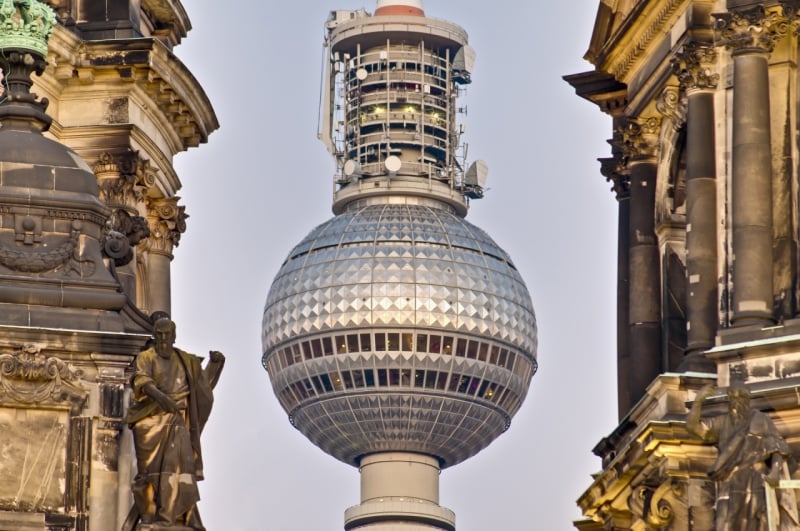
1960s architecture and a viewing platform. The Berliner Fernsehturm or Fernsehturm Berlin is a television tower in central Berlin, Germany.
Located in the Marien quarter (Marienviertel), close to Alexanderplatz in the locality and district of Mitte, the tower was constructed between 1965 and 1969 by the government of the German Democratic Republic (East Germany). It was intended to be both a symbol of Communist power and of the city. It remains a landmark today, visible throughout the central and some suburban districts of Berlin. With its height of 368 metres (including antenna) it is the tallest structure in Germany, and the third-tallest structure in the European Union. When built it was the fourth-tallest freestanding structure in the world after the Ostankino Tower, the Empire State Building and 875 North Michigan Avenue, then known as The John Hancock Center.
Of the four tallest structures in Europe, it is 2 m shorter than the Torreta de Guardamar, 0.5 m shorter than the Riga Radio and TV Tower, and 8 m taller than the Trbovlje Power Station in 2017. The structure is also more than 220 metres higher than the old Berlin Radio Tower in the western part of the city, which was built in the 1920s.
In addition to its main function as the location of several radio and television broadcasting stations, the building – internally known as "Fernmeldeturm 32" – serves as a viewing tower with observation deck including a bar at a height of 203 metres, as well as a rotating restaurant. Also, the Berlin TV Tower can be booked as a venue for events. The distinctive city landmark has undergone a radical, symbolic transformation: After German reunification, it changed from a politically charged, national symbol of the GDR into a citywide symbol of a reunited Berlin. Due to its universal and timeless design, it has increasingly been used as a trademark and is identified worldwide with Berlin and Germany. In 1979, the Berlin TV Tower received monument status by the GDR, a status which was perpetuated after the German reunification.
The tower has become one of the most prominent symbols of the country and is often in the establishing shot of films set in Berlin, alongside monuments such as the Brandenburg Gate, the Berlin Victory Column and the Reichstag building. It is also one of the ten most popular attractions in Germany with more than 1,000,000 visitors every year.[3]
Address: Panoramastraße 1A, 10178 Berlin (Mitte)
Nymphenburg Palace, Munich
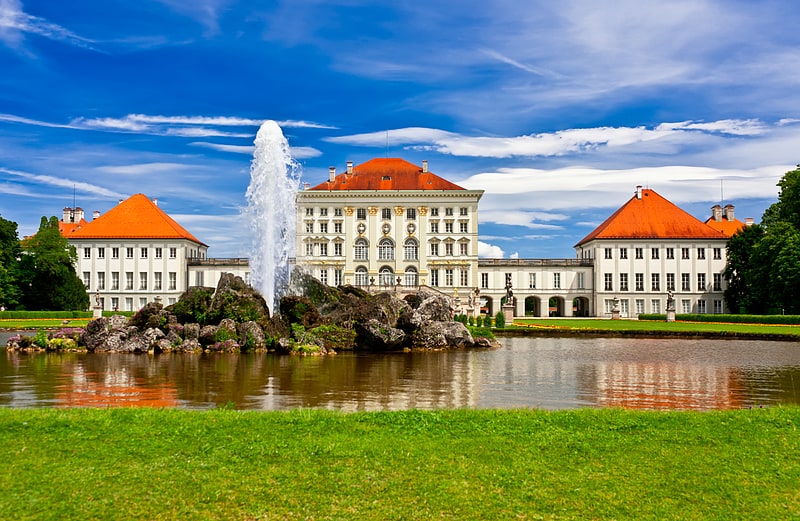
Also known as: Schloss Nymphenburg
Regal 18th-century palace and coach museum. The Nymphenburg Palace is a Baroque palace situated in Munich's western district Neuhausen-Nymphenburg, in Bavaria, southern Germany. Combined with the adjacent Nymphenburg Palace Park it constitutes one of the premier royal palaces of Europe. Its frontal width of 632 m even surpasses Versailles Palace. The Nymphenburg served as the main summer residence for the former rulers of Bavaria of the House of Wittelsbach.[4]
Address: Schloß Nymphenburg 1, 80638 München (Neuhausen - Nymphenburg)
Olympiapark, Munich
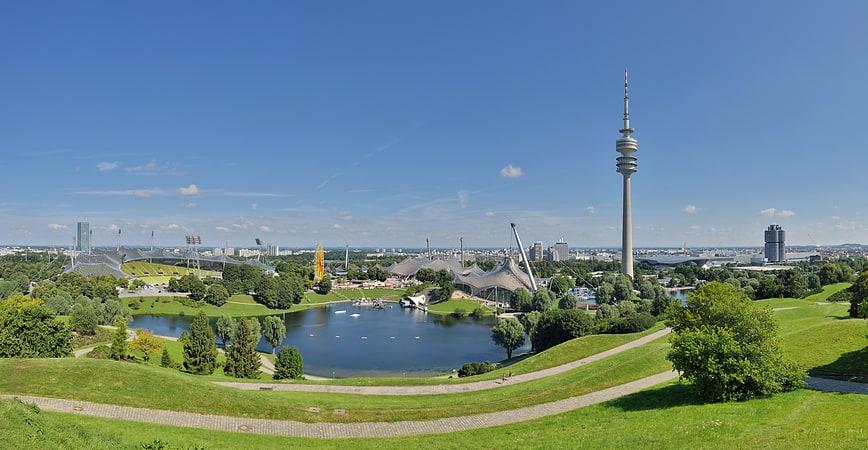
Olympic stadium with tours and attractions. The Olympiapark in Munich, Germany, is an Olympic Park which was constructed for the 1972 Summer Olympics. Located in the Oberwiesenfeld neighborhood of Munich, the Park continues to serve as a venue for cultural, social, and religious events, such as events of worship. It includes a contemporary carillon. The Park is administered by Olympiapark München GmbH, a holding company fully owned by the state capital of Munich.[5]
Address: Spiridon-Louis-Ring 21, 80809 München (Neuhausen - Nymphenburg)
Deutsches Museum, Munich

Exhibitions on science and technology. The Deutsches Museum in Munich, Germany, is the world's largest museum of science and technology, with about 28,000 exhibited objects from 50 fields of science and technology. It receives about 1.5 million visitors per year.
The museum was founded on 28 June 1903, at a meeting of the Association of German Engineers (VDI) as an initiative of Oskar von Miller. It is the largest museum in Munich. For a period of time the museum was used to host pop and rock concerts including The Who, Jimi Hendrix and Elton John.[6]
Address: Museumsinsel 1, 80538 München (Ludwigsvorstadt - Isarvorstadt)
Cologne Cathedral, Cologne
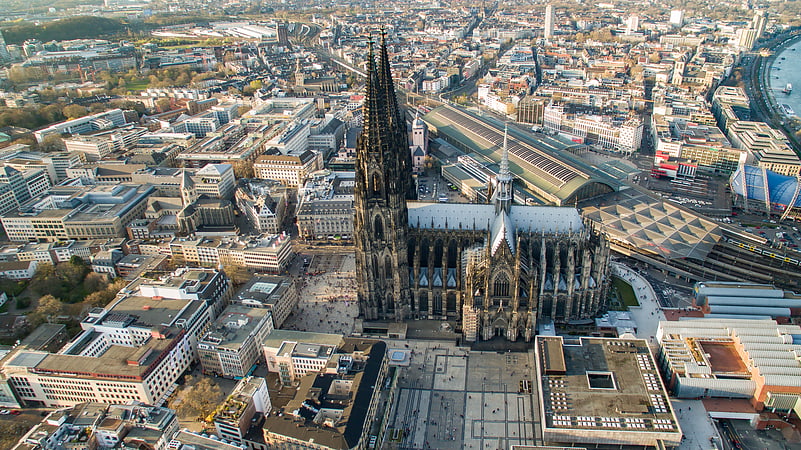
Also known as: Kölner Dom
Grand Gothic cathedral with twin spires. Cologne Cathedral is a Catholic cathedral in Cologne, North Rhine-Westphalia. It is the seat of the Archbishop of Cologne and of the administration of the Archdiocese of Cologne. It is a renowned monument of German Catholicism and Gothic architecture and was declared a World Heritage Site in 1996. It is Germany's most visited landmark, attracting an average of 20,000 people a day. At 157 m, the cathedral is currently the tallest twin-spired church in the world, the second tallest church in Europe after Ulm Minster, and the third tallest church in the world. It is the largest Gothic church in Northern Europe and has the second-tallest spires. The towers for its two huge spires give the cathedral the largest façade of any church in the world. The choir has the largest height-to-width ratio, 3.6:1, of any medieval church.
Construction of Cologne Cathedral began in 1248 but was halted in the years around 1560, unfinished. Work did not restart until the 1840s, and the edifice was completed to its original Medieval plan in 1880.
Cologne's medieval builders had planned a grand structure to house the reliquary of the Three Kings and fit its role as a place of worship for the Holy Roman Emperor. Despite having been left incomplete during the medieval period, Cologne Cathedral eventually became unified as "a masterpiece of exceptional intrinsic value" and "a powerful testimony to the strength and persistence of Christian belief in medieval and modern Europe". Only the telecommunications tower is higher than the Cathedral.[7]
Address: Domkloster 4, 50667 Cologne (Innenstadt)
Hamburger Kunsthalle, Hamburg
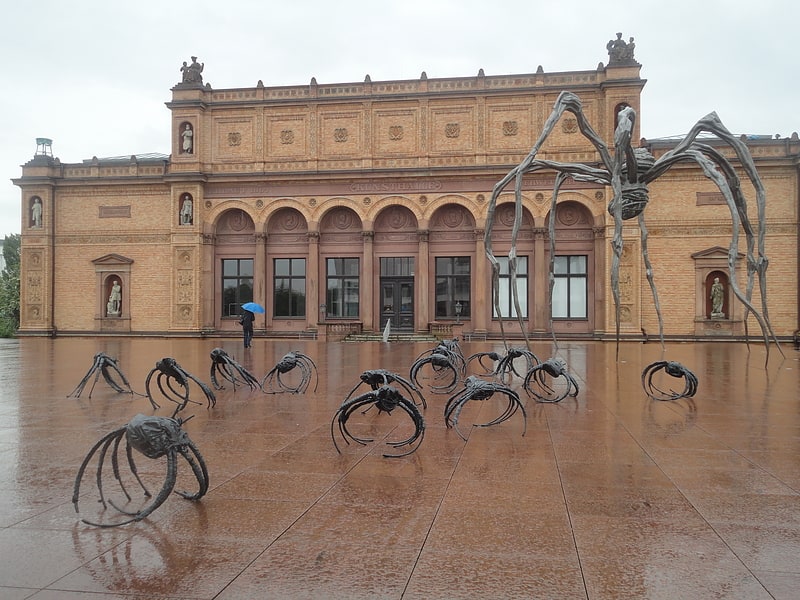
Museum in Hamburg, Germany. The Hamburger Kunsthalle is the art museum of the Free and Hanseatic City of Hamburg, Germany. It is one of the largest art museums in the country. The museum consists of three connected buildings, dating from 1869, 1921 and 1997, located in the Altstadt district between the Hauptbahnhof and the two Alster lakes.
The name Kunsthalle indicates the museum's history as an 'art hall' when it was founded in 1850. Today, the museum houses one of the few art collections in Germany that cover seven centuries of European art, from the Middle Ages to the present day. The Kunsthalle's permanent collections focus on North German painting of the 14th century, paintings by Dutch, Flemish and Italian artists of the 16th and 17th centuries, French and German drawings and paintings of the 19th century, and international modern and contemporary art.[8]
Address: Ferdinandstor 1, 20095 Hamburg (Hamburg-Mitte)
St. Pauli, Hamburg
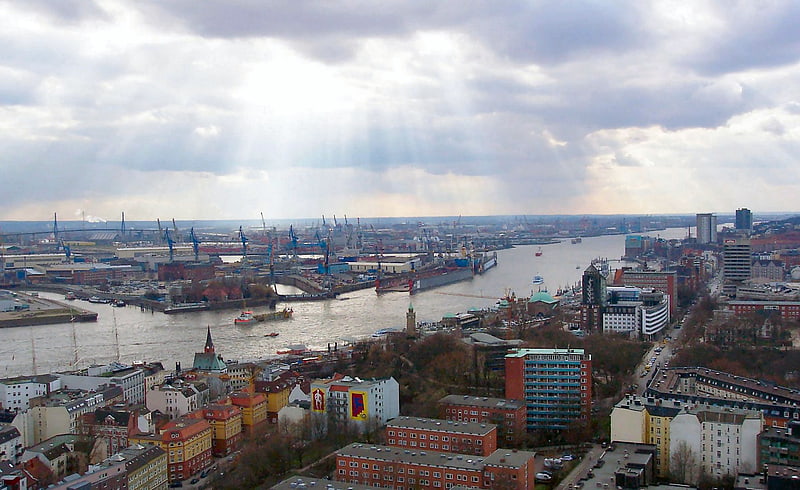
St. Pauli is a quarter of the city of Hamburg belonging to the centrally located Hamburg-Mitte borough. Situated on the right bank of the Elbe river, the nearby Landungsbrücken is a northern part of the port of Hamburg. St. Pauli contains a world-famous red-light district around the iconic Reeperbahn area. As of 2020 the area had 21,902 residents.[9]
Address: 15 Bei der Schilleroper, Hamburg (Hamburg-Mitte)
Museum für Kunst und Gewerbe Hamburg, Hamburg
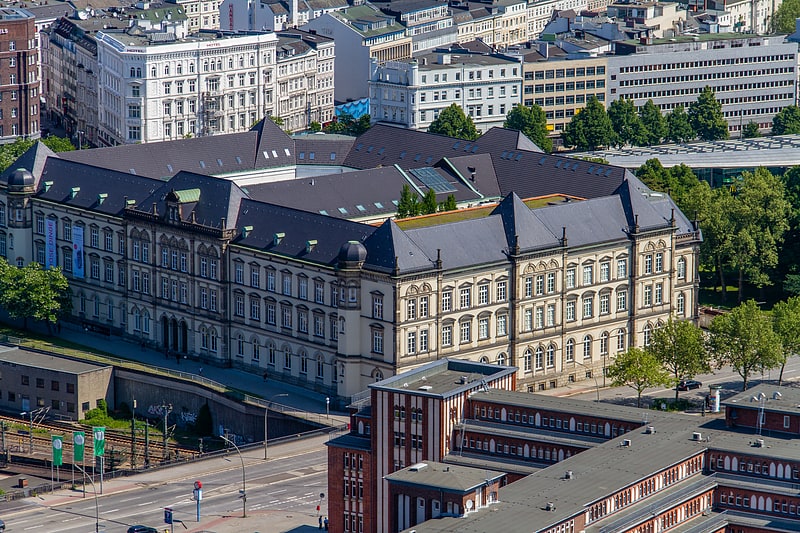
Applied arts, design and industrial museum. The Museum für Kunst und Gewerbe Hamburg is a museum of fine, applied and decorative arts in Hamburg, Germany. It is located centrally, near the Hauptbahnhof.[10]
Address: Steintorplatz 1, 20099 Hamburg (Hamburg-Mitte)
Schokoladenmuseum, Cologne
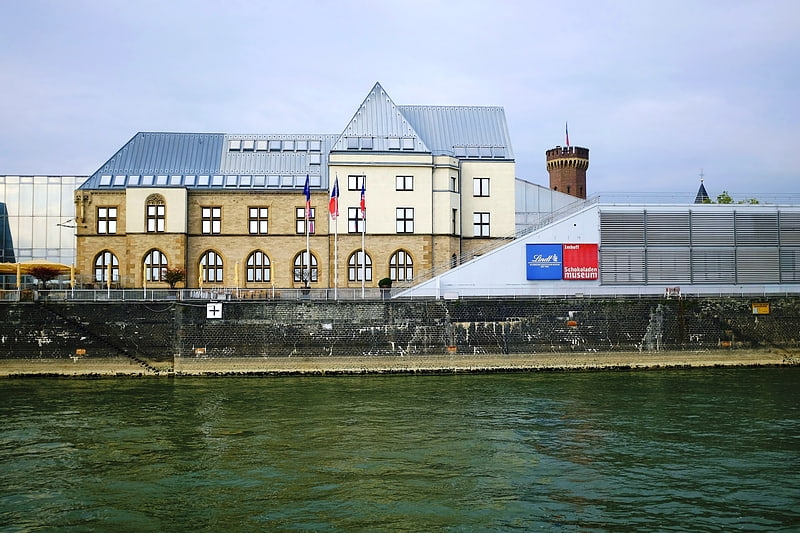
Waterside museum devoted to chocolate. The Imhoff-Schokoladenmuseum was opened by Hans Imhoff on 31 October 1993. It is situated in the Cologne quarter of Altstadt-Süd on the Rheinauhafen peninsula. The exhibits show the entire history of chocolate, from its beginnings with the Olmecs, Maya and Aztecs to contemporary products and production methods.
With 5,000 guided tours and 675,000 visitors a year, the museum is in the Top Ten of German museums. The museum is entirely self-supporting, receiving no subsidy. It has its own marketing department and is used by the Schokoladenmuseum Gastronomie GmbH for events.[11]
Address: Am Schokoladenmuseum 1A, 50678 Köln (Innenstadt)
Mercedes-Benz Museum, Stuttgart
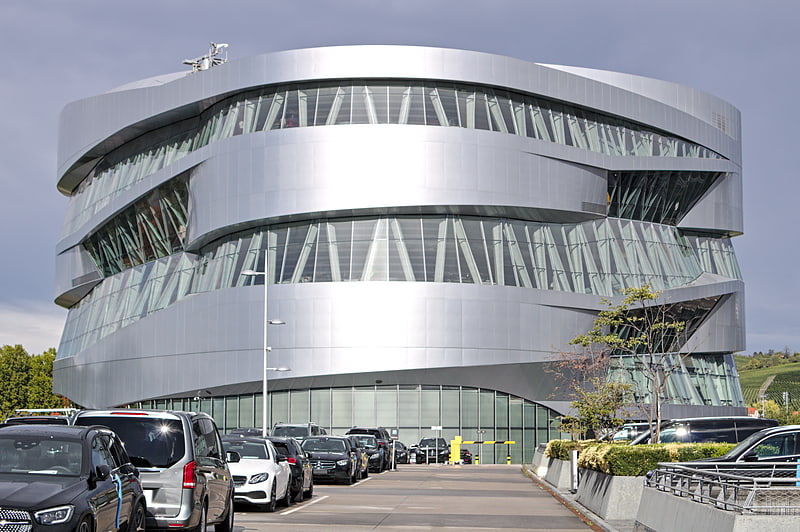
Also known as: Mercedes-Benz Welt
Automobile museum with vintage cars. The Mercedes-Benz Museum is an automobile museum in Stuttgart, Germany. It covers the history of the Mercedes-Benz brand and the brands associated with it. Stuttgart is home to the Mercedes-Benz brand and the international headquarters of the Mercedes-Benz Group.[12]
Address: Mercedesstraße 100, 70372 Stuttgart (Bad Cannstatt)
Zeil, Frankfurt
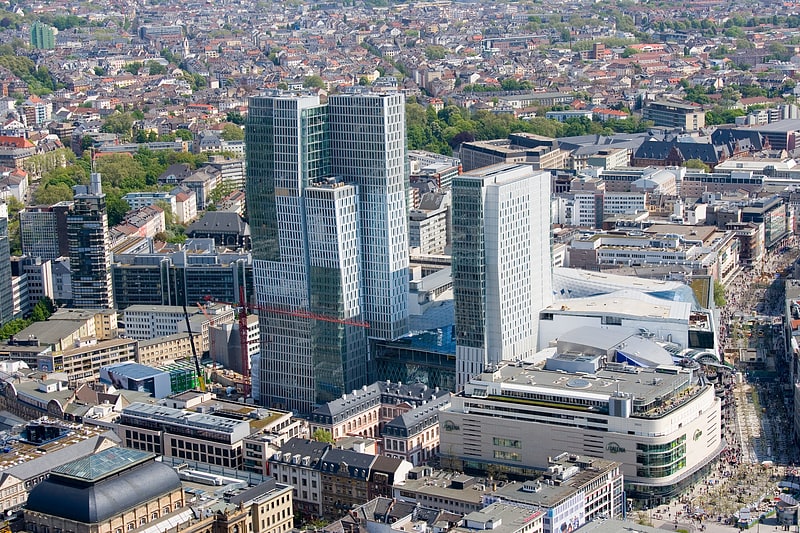
Street in Frankfurt, Germany. The Zeil is a street in the city centre of Frankfurt, Germany. The name, which dates back to the 14th century, is derived from the German word Zeile "row" and originally referred to a row of houses on the eastern end of the north side; the name was not extended to the entire street until later.
Since the end of the 19th century it has been one of the most famous and busiest shopping streets in Germany. Before World War II it was also known for its grand buildings, but most of them were destroyed and not rebuilt. The western part of the Zeil is a pedestrian zone between two large plazas, Hauptwache in the west and Konstablerwache in the east. These two plazas serve as major intersections for underground trains, trams and buses. The eastern part of the Zeil, called "New Zeil", connects Konstablerwache with the Friedberger Anlage.
The Zeil underwent a major renovation from spring 2008 until summer 2009. The pedestrian zone was extended to the west as far as the Börsenstraße. This brought drastic changes for motorists because the route via Hauptwache, which is an important north-south connection for individual traffic, was closed.[13]
Gemäldegalerie Alte Meister, Dresden
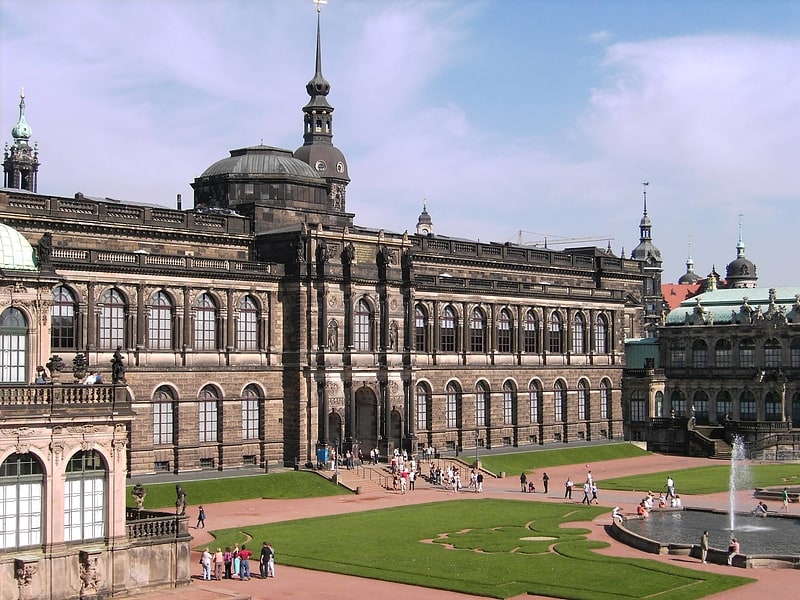
World-renowned collection of paintings. The Gemäldegalerie Alte Meister in Dresden, Germany, displays around 750 paintings from the 15th to the 18th centuries. It includes major Italian Renaissance works as well as Dutch and Flemish paintings. Outstanding works by German, French, and Spanish painters of the period are also among the gallery's attractions.
The Old Masters are part of the Dresden State Art Collections. The collection is located in the Semper Gallery, the gallery wing of the Zwinger.[14]
Address: Theaterplatz 1, 01067 Dresden (Altstadt)
Wilhelma, Stuttgart

Zoo and botanical gardens in huge park. Wilhelma is a zoological-botanical garden in Stuttgart in the Bad Cannstatt district in the north of the city on the grounds of a historic castle. Wilhelma Zoo is one of the most popular tourist destinations in Baden-Württemberg, seeing more than 2 million visitors annually.
The Zoo and Botanical Garden have been staffed since 1846. The Moorish Revival style echoing the Alhambra have been maintained and supplemented since 1960. Today, the zoo has an area of about 30 hectares (0.30 km2), houses around 11,500 animals from around the world composed of roughly 1,200 species and roughly 6000 plants from all climates. Of Germany's zoos, Wilhelma's collection ranks second to the Berlin Zoological Garden. In addition to the public garden, Wilhelma also has a branch office located in Fellbach, where the zoo keeps its stallions.
Wilhelma receives gorilla juveniles rejected by their mother and reared by the zookeepers. At age 2-3, the gorillas are sent back to their original zoo(s).[15]
Address: Stuttgart, Wilhelma 13, 70376 Stuttgart, Germany
Goethestraße, Frankfurt

Street in Frankfurt, Germany. Goethestraße is a luxury shopping street in the city centre of Frankfurt, Germany, located between Opernplatz and Börsenstraße and Goetheplatz in the district of Innenstadt and within the Opera Quarter and the broader central business district known as the Bankenviertel. It is a parallel street of Freßgass and located in the immediate vicinity of Kaiserhofstraße. The street is Germany's third-busiest luxury shopping street.
The street was constructed between 1892 and 1894 and named for Johann Wolfgang von Goethe.[16]
Skyline Plaza, Frankfurt
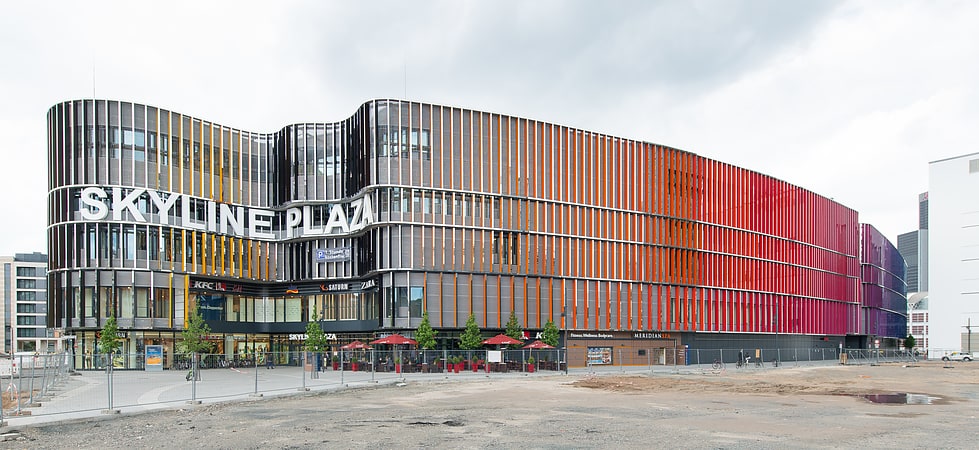
Building complex. Skyline Plaza is a building complex in the western part of Frankfurt, Germany, near the trade fair premises of Messe Frankfurt. It is planned to consist of four buildings:
- a shopping mall with around 180 shops and restaurants (opened on 29 August 2013) and a large spa (opening scheduled for February 2014)
- a congress center for Messe Frankfurt (opening scheduled for June 2014)
- a 191 m (627 ft) office tower (under construction)
- Grand Tower: a 180 m (590 ft) residential tower (finished)
Address: Europa-Allee 6, 60327 Frankfurt am Main (Innenstadt)
Schloss Pillnitz, Dresden
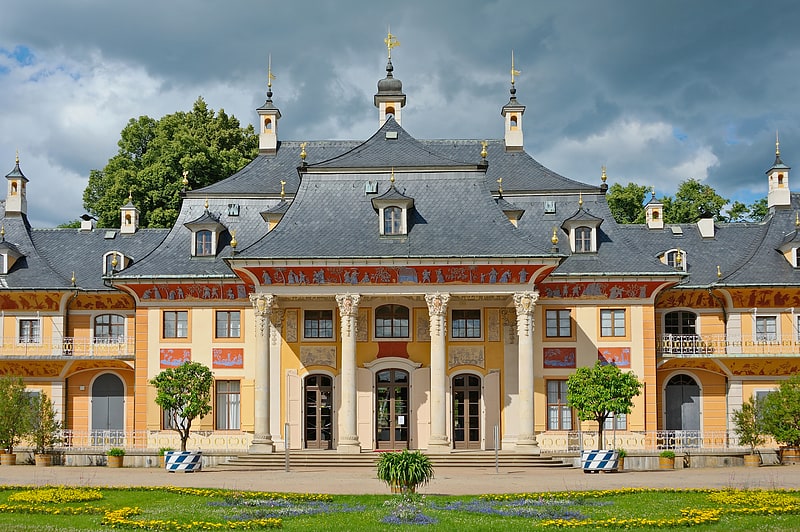
Restored renaissance palace with gardens. Pillnitz Palace is a restored Baroque schloss at the eastern end of the city of Dresden in the German state of Saxony. It is located on the bank of the River Elbe in the former village of Pillnitz. It was the summer residence of many electors and kings of Saxony; it is also known for the Declaration of Pillnitz in 1791.
The complex consists of three main buildings, the Riverside Palace (Wasserpalais) on the riverfront; the Upper Palace (Bergpalais) on the hillside, both Baroque with Chinoiserie elements; and the later Neoclassical New Palace (Neues Palais), which links them together on the east side. The buildings enclose a Baroque garden and are surrounded by a large public park.
Today, the buildings house the arts and crafts museum (Kunstgewerbemuseum) of the Dresden State Art Collections and a Schlossmuseum.[18]
Address: August-Böckstiegel-Straße 2, 01326 Dresden (Loschwitz)
Sanssouci, Potsdam
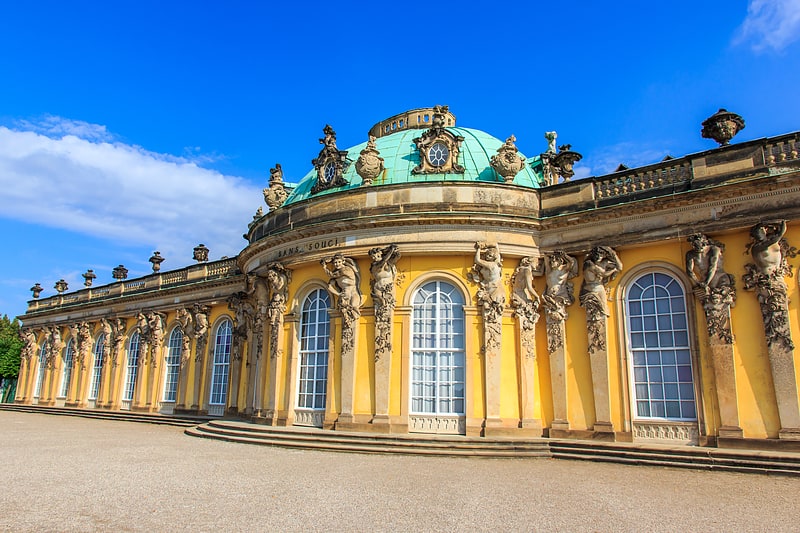
Iconic palace of Frederick the Great. Sanssouci is a historical building in Potsdam, near Berlin. Built by Prussian King Frederick the Great as his summer palace, it is often counted among the German rivals of Versailles. While Sanssouci is in the more intimate Rococo style and is far smaller than its French Baroque counterpart, it, too, is notable for the numerous temples and follies in the surrounding park. The palace was designed and built by Georg Wenzeslaus von Knobelsdorff between 1745 and 1747 to meet Frederick's need for a private residence where he could escape the pomp and ceremony of the royal court. The palace's name is a French phrase that translates as "without concerns", meaning "without worries" or "carefree", emphasising that the palace was meant as a place of relaxation, rather than a seat of power.
Sanssouci is little more than a large, single-story villa—more like the Château de Marly than Versailles. Containing just ten principal rooms, it was built on the brow of a terraced hill at the centre of the park. The influence of King Frederick's personal taste in the design and decoration of the palace was so great that its style is characterised as "Frederician Rococo", and his feelings for the palace were so strong that he conceived it as "a place that would die with him". Because of a disagreement about the site of the palace in the park, Knobelsdorff was fired in 1746. Jan Bouman, a Dutch architect, finished the project.
During the 19th century, the palace became a residence of Frederick William IV. He employed the architect Ludwig Persius to restore and enlarge the palace, while Ferdinand von Arnim was charged with improving the grounds and thus the view from the palace. The town of Potsdam, with its palaces, was a favourite place of residence for the German imperial family until the fall of the Hohenzollern dynasty in 1918.
After World War II, the palace became a tourist attraction in East Germany. Following German reunification in 1990, Frederick's body was returned to the palace and buried in a new tomb overlooking the gardens he had created. Sanssouci and its extensive gardens became a World Heritage Site in 1990 under the protection of UNESCO; in 1995, the Prussian Palaces and Gardens Foundation Berlin-Brandenburg was established to care for Sanssouci and the other former imperial palaces in and around Berlin. These palaces are now visited by more than two million people each year from all over the world.[19]
Aachen Cathedral, Aachen
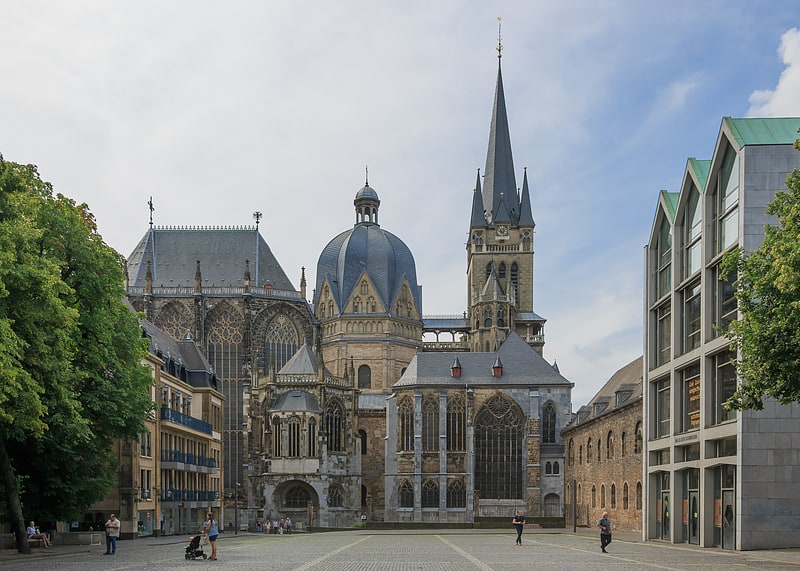
Also known as: Aachener Dom
Iconic cathedral and Charlemagne's chapel. Aachen Cathedral,a Roman Catholic church in Aachen, Germany and the seat of the Roman Catholic Diocese of Aachen.
One of the oldest cathedrals in Europe, it was constructed by order of Emperor Charlemagne, who was buried there in 814. From 936 to 1531, the Palatine Chapel saw the coronation of thirty-one German kings and twelve queens. The church has been the mother church of the Diocese of Aachen since 1930.[20]
Address: Klosterplatz 2, 52062 Aachen (Aachen Mitte)
Mathematisch-Physikalischer Salon, Dresden
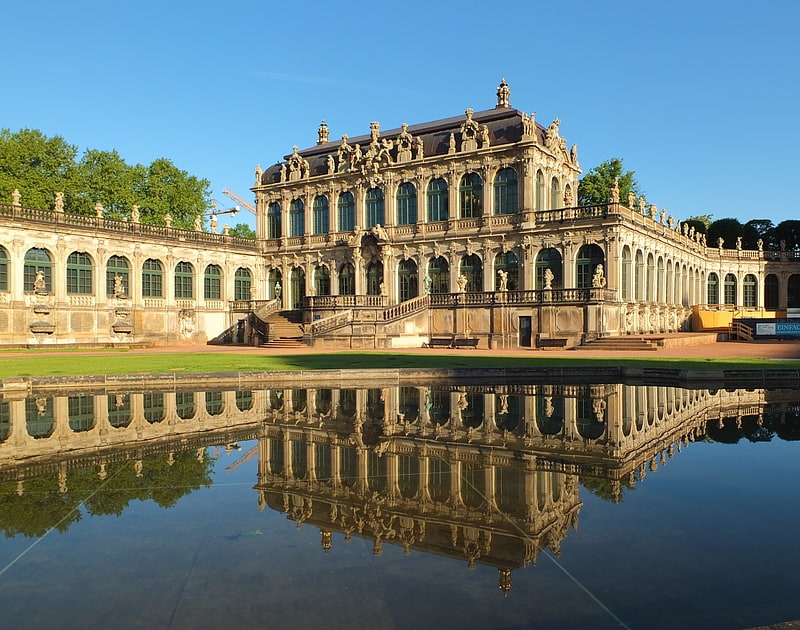
Scientific instrument and clock museum. The Mathematisch-Physikalischer Salon in Dresden, Germany, is a museum of historic clocks and scientific instruments. Its holdings include terrestrial and celestial globes, astronomical, optical and geodetic devices dating back to the 16th century, as well as historic instruments for calculating and drawing length, mass, temperature and air pressure.
The Mathematisch-Physikalischer Salon is part of the Staatliche Kunstsammlungen Dresden (State Art Collections). It is located in the Zwinger.[21]
Address: im Dresdener Zwinger, 01067 Dresden (Altstadt)
Porsche Museum, Stuttgart

Also known as: Porsche-Museum
Showcase of legendary racing cars. The Porsche Museum is an automobile museum in the Zuffenhausen district of Stuttgart, Germany on the site of carmaker Porsche.[22]
Address: Porscheplatz 1, 70435 Stuttgart (Zuffenhausen)
Zollverein Coal Mine Industrial Complex, Essen
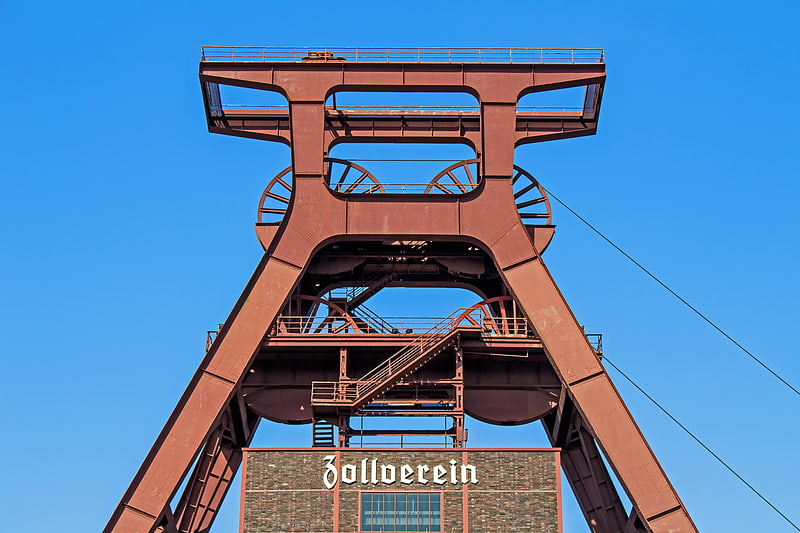
Also known as: Zeche Zollverein
Coal mining museum and monument. The Zollverein Coal Mine Industrial Complex is a large former industrial site in the city of Essen, North Rhine-Westphalia, Germany. It has been inscribed into the UNESCO list of World Heritage Sites since December 14, 2001, and is one of the anchor points of the European Route of Industrial Heritage.
The first coal mine on the premises was founded in 1847, and mining activities took place from 1851 until December 23, 1986. For decades, starting in the late 1950s, the two parts of the site, Zollverein Coal Mine and Zollverein Coking Plant (erected 1957−1961, closed on June 30, 1993), ranked among the largest of their kinds in Europe. Shaft 12, built in the New Objectivity style, was opened in 1932 and is considered an architectural and technical masterpiece, earning it a reputation as the "most beautiful coal mine in the world".[23]
Address: Gelsenkirchener Str. 181, 45309 Essen (Südoststadt)
Hohe Straße, Cologne
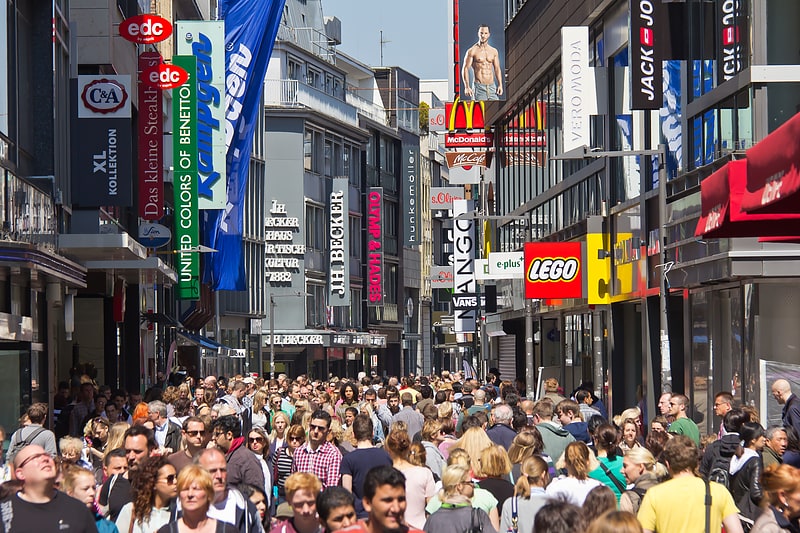
Street in Cologne, Germany. Hohe Straße is a shopping street in the old town of Cologne, Germany, and one of the city's both oldest and busiest streets. Together with many of its adjacent side streets, Hohe Straße is part of a designated pedestrian zone and spans about 680 metres from Cologne Cathedral on its Northern end to Schildergasse on its Southern end.[24]
Address: Hohe Str., 50667 Köln (Innenstadt)
Rheinturm, Düsseldorf
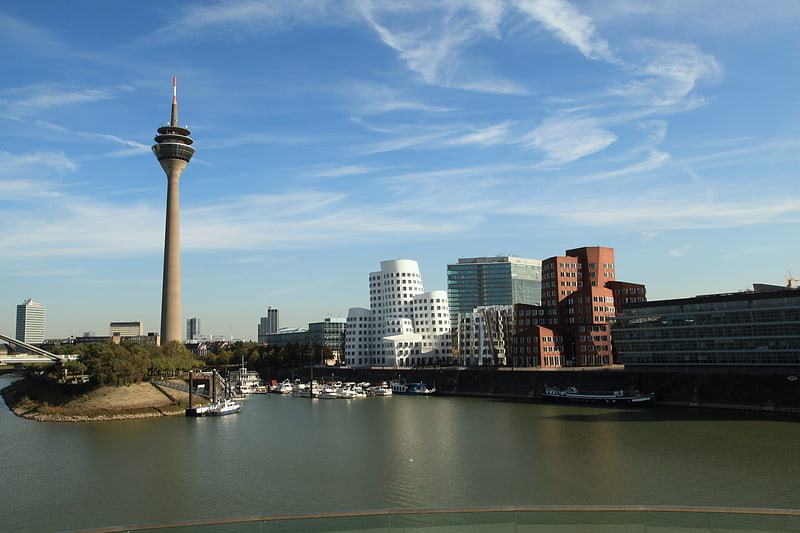
Tower in Düsseldorf, Germany. The Rheinturm is a 240.5-metre-high concrete telecommunications tower in Düsseldorf, capital of the federal state of North Rhine-Westphalia, Germany. Construction commenced in 1979 and finished in 1981. The Rheinturm carries aerials for directional radio, FM and TV transmitters. It stands 174.5 metres high and houses a revolving restaurant and an observation deck at a height of 170 metres. It is the tallest building in Düsseldorf.
The Rheinturm was inaugurated on 1 December 1981. It contains 7,500 cubic metres of concrete and weighs 22,500 tons. Before October 15, 2004, when an aerial antenna for DVB-T was mounted, it was 234.2 metres high.
The observation deck is open to public daily from 10:00 to 23:30. As a special attraction, a light sculpture on its shaft works as a clock. This sculpture was designed by Horst H. Baumann and is called Lichtzeitpegel (light time level). The light sculpture on the Rheinturm is the largest digital clock in the world.[25]
Address: Stromstraße 20, 40221 Düsseldorf (Stadtbezirke 03)
Germanisches Nationalmuseum, Nuremberg
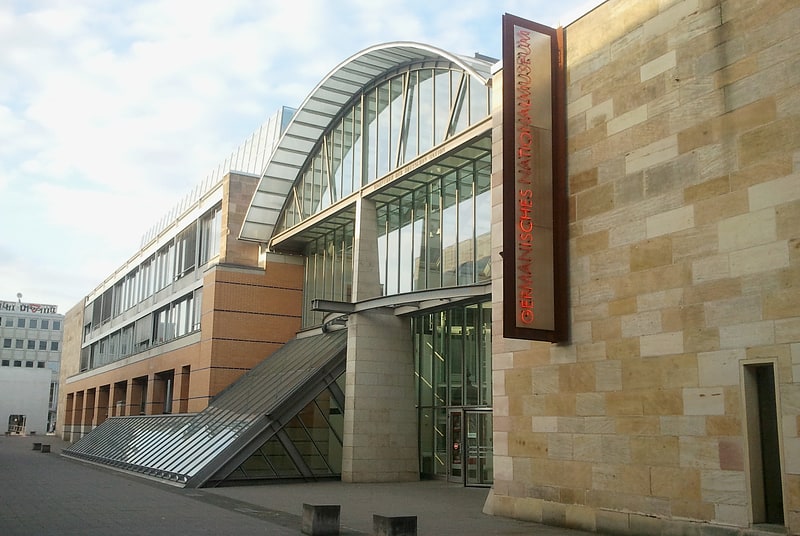
Museum in Nuremberg, Germany. The Germanisches National Museum is a museum in Nuremberg, Germany. Founded in 1852, it houses a large collection of items relating to German culture and art extending from prehistoric times through to the present day. The Germanisches National Museum is Germany's largest museum of cultural history. Out of its total holding of some 1.3 million objects, approximately 25,000 are exhibited.
The museum is situated in the south of the historic city center between Kornmarkt and Frauentormauer along the medieval city wall. Its entrance hall is situated on Kartäusergasse which was transformed by the Israeli sculptor Dani Karavan to the Way of Human Rights (German: Straße der Menschenrechte).[26]
Address: Kartäusergasse 1, 90402 Nürnberg (Mitte)
New Palace, Potsdam
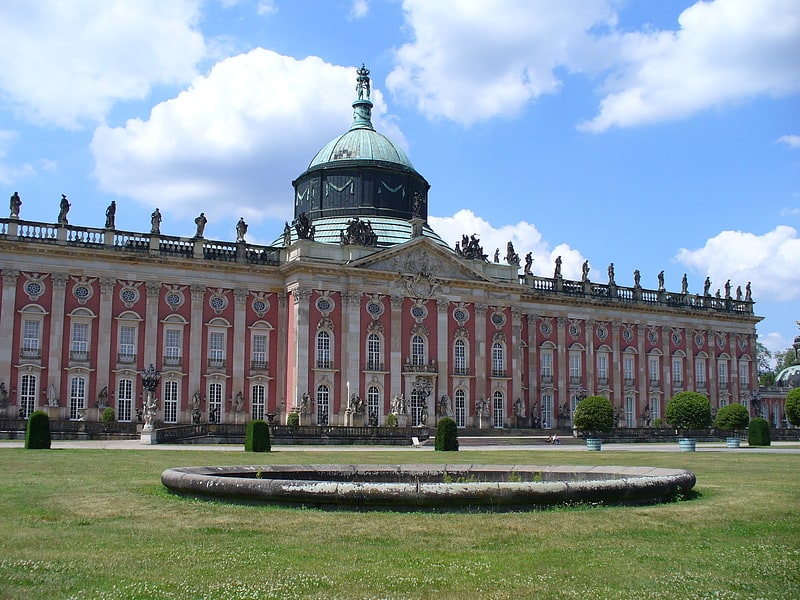
Also known as: Neues Palais
Rococo interiors in 18th-century palace. The New Palace is a palace situated on the western side of the Sanssouci park in Potsdam, Germany. The building was begun in 1763, after the end of the Seven Years' War, under King Friedrich II and was completed in 1769. It is considered to be the last great Prussian Baroque palace.[27]
Address: Am Neuen Palais, 14469 Potsdam (Westliche Vorstadt)
Holstentor, Lübeck
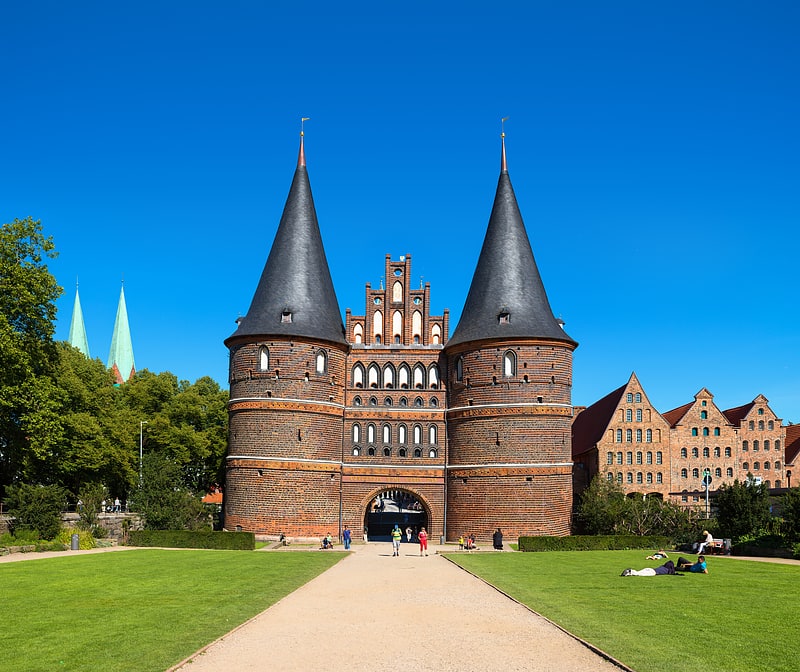
Museum in an iconic Gothic city gate. The Holsten Gate is a city gate marking off the western boundary of the old center of the Hanseatic city of Lübeck. Built in 1464, the Brick Gothic construction is one of the relics of Lübeck's medieval city fortifications and one of two remaining city gates, the other being the Citadel Gate. Known for its two-round towers and arched entrance, it is regarded today as a symbol of the city. Together with the old city centre of Lübeck it has been a UNESCO World Heritage Site since 1987.[28]
Schloss Babelsberg, Potsdam
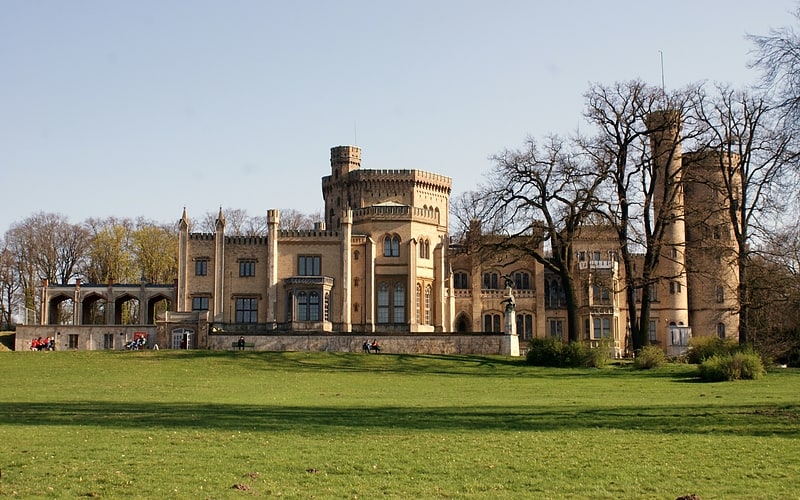
Castle in Potsdam, Germany. Babelsberg Palace lies in the eponymous park and quarter of Potsdam, the capital of the German state of Brandenburg, near Berlin. For over 50 years it was the summer residence of Prince William, later German Emperor William I and King of Prussia and his wife, Augusta of the House of Saxe-Weimar-Eisenach, German Empress and Queen of Prussia.[29]
Address: Park Babelsberg 10, 14482 Potsdam (Babelsberg)
Museum Folkwang, Essen
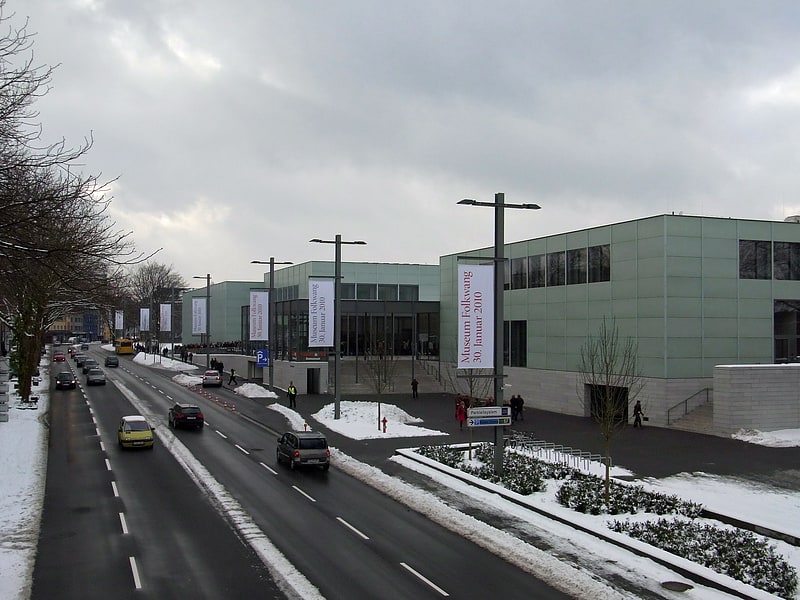
Museum in Essen, Germany. Museum Folkwang is a major collection of 19th- and 20th-century art in Essen, Germany. The museum was established in 1922 by merging the Essener Kunstmuseum, which was founded in 1906, and the private Folkwang Museum of the collector and patron Karl Ernst Osthaus in Hagen, founded in 1902.
The term Folkwang derives from the name of the afterlife meadow of the dead, Fólkvangr, presided over by the Norse goddess Freyja.
Museum Folkwang incorporates the Deutsche Plakat Museum (German poster museum), comprising circa 340,000 posters from politics, economy and culture. During a visit in Essen in 1932, Paul J. Sachs called the Folkwang "the most beautiful museum in the world."
In 2007, David Chipperfield designed an extension, which was then built onto the older building.[30]
Address: Museumsplatz 1, 45128 Essen (Stadtmitte - Frillendorf - Huttrop)
Roland, Bremen

Emblematic statue built in 15th-century. The Bremen Roland is a statue of Roland, erected in 1404. It stands in the market square of Bremen, Germany, facing the cathedral, and shows Roland, paladin of the first Holy Roman Emperor Charlemagne and hero of the Battle of Roncevaux Pass. Roland is shown as protector of the city: his legendary sword is unsheathed, and his shield is emblazoned with the two-headed Imperial eagle.
The standing figure is 5.47 m tall, and stands on a 60 cm rostrum. A supporting column, crowned by a baldachin, brings the combined height to 10.21 m. The statue was carved in limestone from the Elm, and was commissioned by the city fathers to replace a wooden one burnt in 1366 by Prince-Archbishop Albert II. It confronts the church as a representation of city rights opposed to the territorial claims of the prince-archbishop.
The inscription on the shield reads: "vryheit do ik ju openbar / d’ karl vnd mēnich vorst vorwar / desser stede ghegheuen hat / des danket god’ is mī radt"
This translates in English to: "Freedom I do manifest to you / which Karl and many noblemen indeed / have given to this place. / Thank God for this is my advice."
Statues of Roland appear in numerous cities of the former Holy Roman Empire, as emblems of city liberties, Stadtrechte. The Roland statue at Bremen is the oldest surviving example. From Bremen the symbol of civic liberty and freedom spread to other cities and has become a symbol of the new Europe. Since 1973, it is protected by the monument protection act. In July 2004, along with the town hall, the statue was added to the list of UNESCO World Heritage Sites.[31]
Address: Am Markt, 28195 Bremen (Mitte)
Altstadt, Düsseldorf
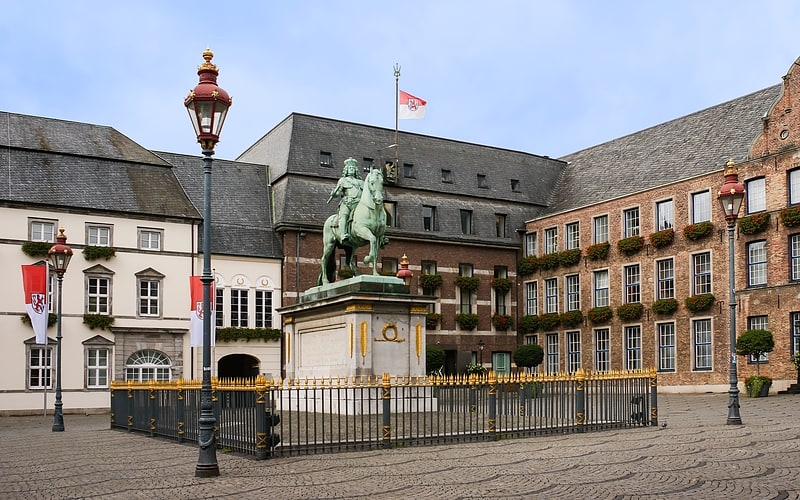
The Altstadt is one of the 49 boroughs of Düsseldorf, Germany; it belongs to central City District 1. The Düsseldorfer Altstadt is known as "the longest bar in the world", because the small Old Town has more than 300 bars and discothèques; supposedly, each establishment's bar-counter connecting to one next door.
Düsseldorf is famed for its special beer, Altbier ("old beer"), brewed from an old traditional recipe, which is only produced in a few places in the world since the end of the 19th century.
The Old Town has an area of half a square kilometer (which is less than a quarter of a percent of the whole city) and has 2297 inhabitants (2000), less than half a percent of the population of Düsseldorf. The density of population is thus 4594 inhabitants/km2.[32]
Bergpark Wilhelmshöhe, Kassel
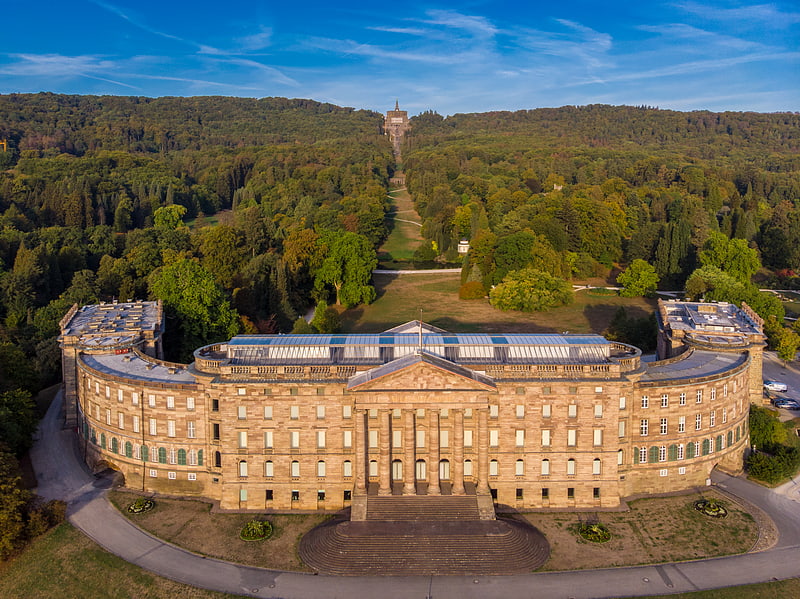
Palatial, fine art and antiquities museum. Bergpark Wilhelmshöhe is a landscape park in Kassel, Germany. The area of the park is 2.4 square kilometres, making it the largest European hillside park, and second largest park on a hill slope in the world. Construction of the Bergpark, or "mountain park", began in 1689 at the behest of the Landgraves of Hesse-Kassel and took about 150 years. The park is open to the public today. Since 2013, it has been a UNESCO World Heritage Site.[33]
City Hall, Bremen
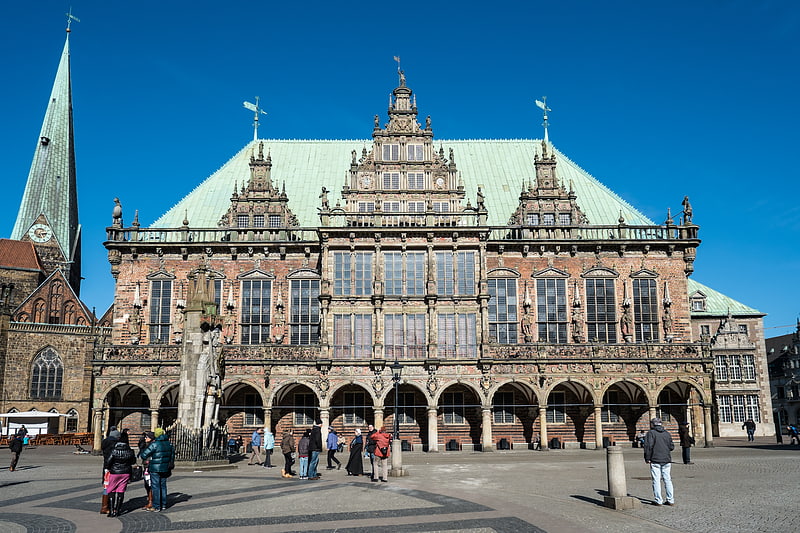
Also known as: Bremer Rathaus
600-year-old town hall with a restaurant. The Bremen City Hall is the seat of the President of the Senate and Mayor of the Free Hanseatic City of Bremen. It is one of the most important examples of Brick Gothic and Weser Renaissance architecture in Europe. Since 1973, it has been a protected historical building. In July 2004, along with the Bremen Roland statue, the building was added to the list of UNESCO World Heritage Sites.[34]
Address: Am Markt 21, 28195 Bremen (Mitte)
Leipzig Zoological Garden, Leipzig
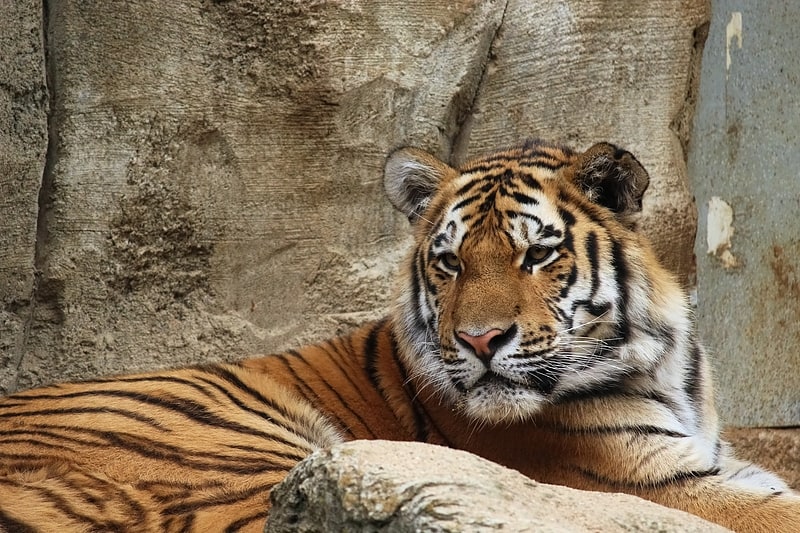
Also known as: Zoo Leipzig
Established zoo with conservation focus. Leipzig Zoological Garden, or Leipzig Zoo is a zoo in Leipzig city, Germany. It was first opened on June 9, 1878. It was taken over by the city of Leipzig in 1920 after World War I and now covers about 27 hectares and contains approximately 850 species. By 2020 the zoo featured six different theme worlds, aiming at providing habitats appropriate for the species on display.
Leipzig zoo is internationally noted for its large building projects such as Pongoland (housing gorillas, chimpanzees, bonobo and orangutans) and Gondwanaland (world's second largest indoor rainforest hall at 1.65 ha or 4.1 acres). It has bred more than 2,000 lions, 250 rare Siberian tigers, and other carnivores like bears. Leipzig Zoological Garden has been called the "Zoo of the future". It is ranked as the best zoo in Germany and also the second-best in Europe (after Vienna).[35]
Address: Pfaffendorfer Str. 29, 04105 Leipzig (Mitte)
Porta Nigra, Trier

Towering stone Roman gate. The Porta Nigra is a large Roman city gate in Trier, Germany. It is today the largest Roman city gate north of the Alps. It is designated as part of the Roman Monuments, Cathedral of St Peter and Church of Our Lady in Trier UNESCO World Heritage Site.
The name Porta Nigra originated in the Middle Ages due to the darkened colour of its stone; the original Roman name has not been preserved. Locals commonly refer to the Porta Nigra simply as Porta.[36]
Address: Simeonstrasse 60, 54290 Trier
High Cathedral of Saint Peter, Trier
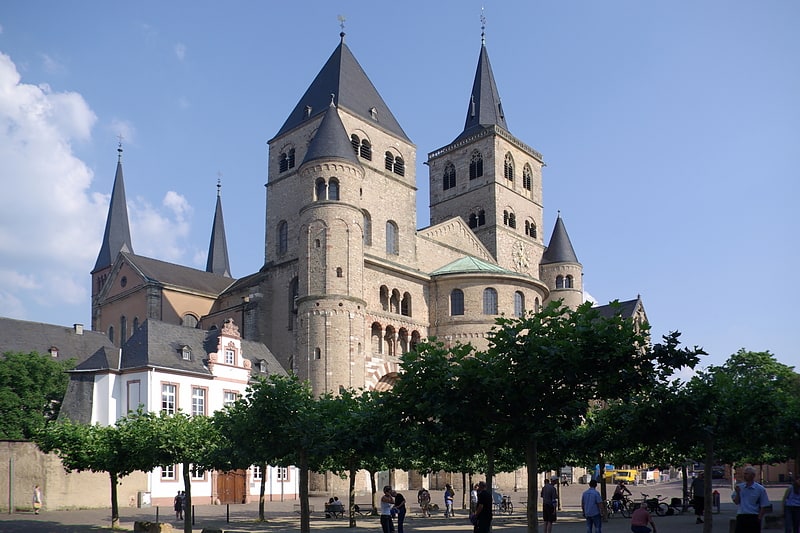
Also known as: Trierer Dom
Fortress-like cathedral founded in 1035. The High Cathedral of Saint Peter in Trier, or Trier Cathedral, is a Roman Catholic cathedral in Trier, Rhineland-Palatinate, Germany. It is the oldest church in Germany and the largest religious structure in Trier, notable for its long life span and grand design. The central part of the nave was built of Roman brick in the early fourth century, resulting in a cathedral that was added onto gradually in different eras. The imposing Romanesque westwork, with four towers and an additional apse, has been copied repeatedly. The Trier Cathedral Treasury contains an important collection of Christian art. In 1986 the church was listed as a UNESCO World Heritage Site, as part of the Roman Monuments, Cathedral of St. Peter and Church of Our Lady in Trier.[37]
Address: Liebfrauenstraße 12, 54290 Trier
Schloss Heidelberg, Heidelberg
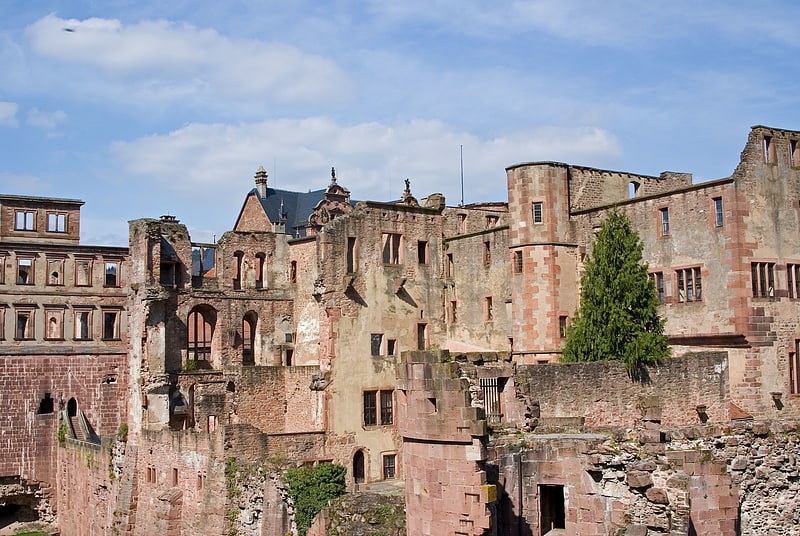
Also known as: Heidelberger Schloss
16th-century ruined castle on a hillside. Heidelberg Castle is a ruin in Germany and landmark of Heidelberg. The castle ruins are among the most important Renaissance structures north of the Alps.
The castle has only been partially rebuilt since its demolition in the 17th and 18th centuries. It is located 80 metres (260 ft) up the northern part of the Königstuhl hillside, and thereby dominates the view of the old downtown. It is served by an intermediate station on the Heidelberger Bergbahn funicular railway that runs from Heidelberg's Kornmarkt to the summit of the Königstuhl.
The earliest castle structure was built before 1214 and later expanded into two castles circa 1294; however, in 1537, a lightning bolt destroyed the upper castle. The present structures had been expanded by 1650, before damage by later wars and fires. In 1764, another lightning bolt caused a fire which destroyed some rebuilt sections.[38]
Address: Schloss Heidelberg, 69117 Heidelberg
Kaiserthermen, Trier
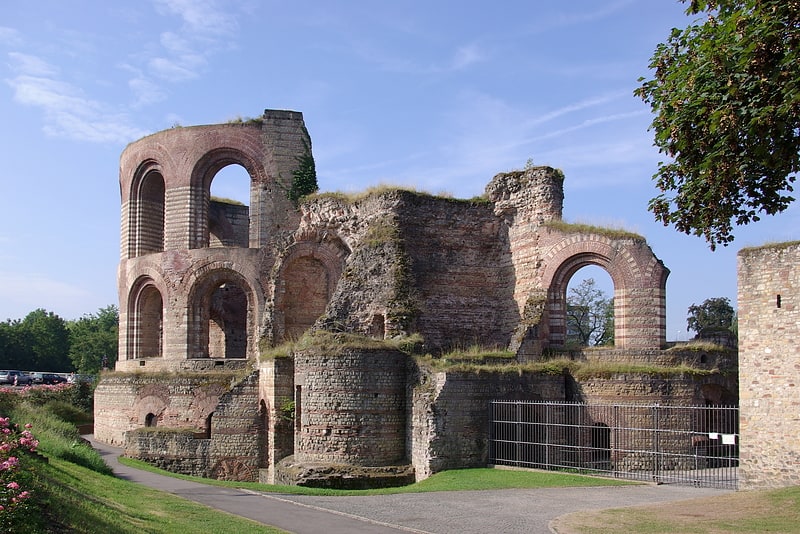
Historical landmark in Trier, Germany. The Trier Imperial Baths are a large Roman bath complex in Trier, Germany. It is designated as part of the Roman Monuments, Cathedral of St. Peter and Church of Our Lady in Trier UNESCO World Heritage Site. It was constructed in the 4th century AD. The baths were never completed and were made into a castle in the Middle Ages.[39]
Address: Südallee 10-12, 54294 Trier
Villa Hügel, Essen
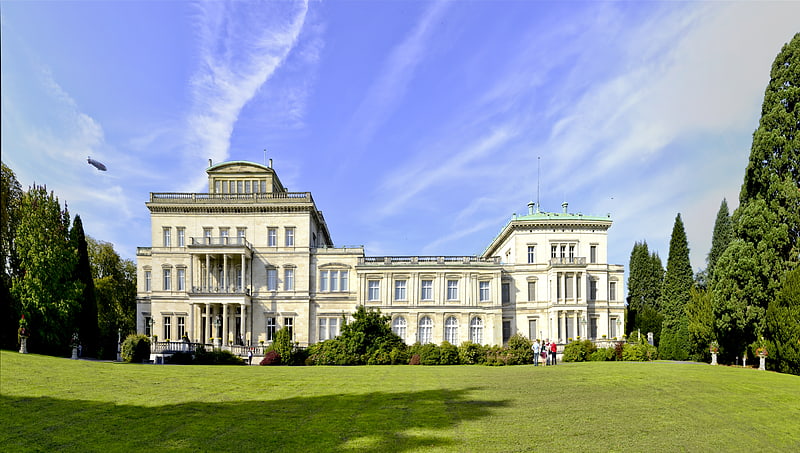
19th-century industrialist's manor house. The Villa Hügel is a 19th-century mansion in Bredeney, now part of Essen, Germany. It was built by the industrialist Alfred Krupp in 1870-1873 as his main residence and was the home of the Krupp family until after World War II. More recently, the Villa Hügel has housed the offices of the Kulturstiftung Ruhr, an art gallery, the historical archive of the Krupp family and company, and a concert venue.
Hügel simply means “hill”, as the villa sits atop a hill. It was sometimes named Villa Krupp, after the family.[40]
Address: Hügel 15, 45133 Essen (Werden - Kettwig - Bredeney)
Hercules monument, Kassel
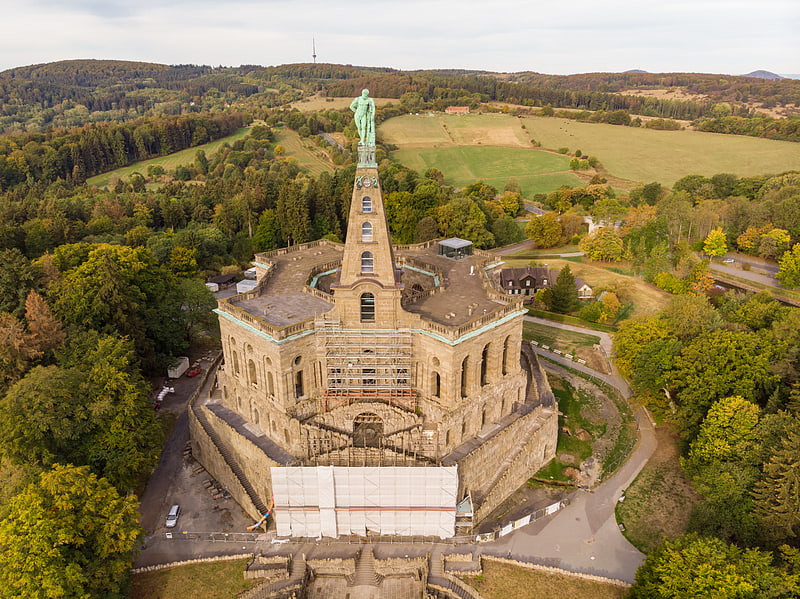
Also known as: Herkules
Complex devoted to ancient Greek demigod. The Hercules monument is an important landmark in the German city of Kassel. It is located in the Bergpark Wilhelmshöhe in northern Hesse, Germany.
Hercules is a copper statue depicting the ancient Greek demigod Heracles (Gr. Ηρακλής, German Herkules). The statue is located at the top of a Pyramid, which stands on top of the Octagon; the statue and the other parts of the monument were constructed at different times. Today "Hercules" refers not only to the statue, but the whole monument, including the Octagon and Pyramid. The monument is the highest point in the Wilhelmshöhe Bergpark.
The monument is located in Bad Wilhelmshöhe, on the Eastern ridge of the Habichtswald. It was built in an artificial dell of the Karlsberg (526m above sea level) on the most western and at the same time highest location (515 m) of the line of sight Schloss Wilhelmshöhe – Hercules.
On 23 June 2013 the Mountainpark and the Hercules were proclaimed as World Heritage Site during the UNESCO meeting in Phnom Penh.[41]
Address: Schlosspark 28, 34131 Kassel (Kassel West)
Schloss Benrath, Düsseldorf
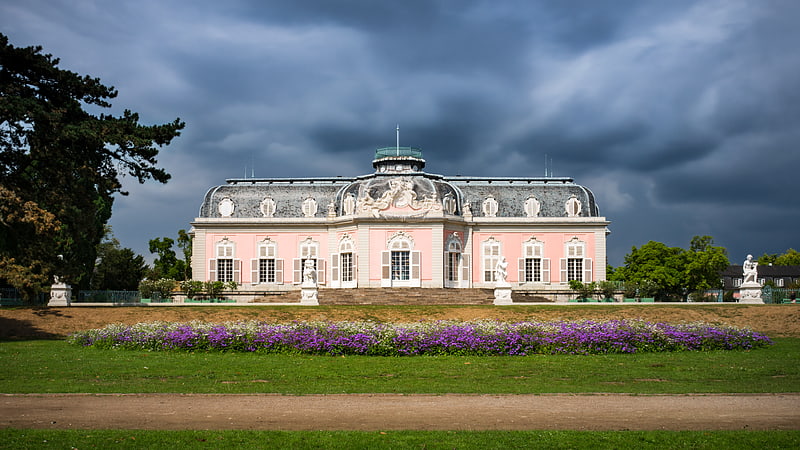
18th-century palace with museum and events. Schloss Benrath is a Baroque-style maison de plaisance in Benrath, which is now a borough of Düsseldorf. It was erected for the Elector Palatine Charles Theodor and his wife, Countess Palatine Elisabeth Auguste of Sulzbach, by his garden and building director Nicolas de Pigage. Construction began in 1755 and was completed in 1770. The ensemble at Benrath has been proposed for designation as a UNESCO World Heritage Site.[42]
Address: Benrather Schlossallee 100-106, 40597 Dusseldorf (Stadtbezirke 09)
Hanover Zoo, Hanover
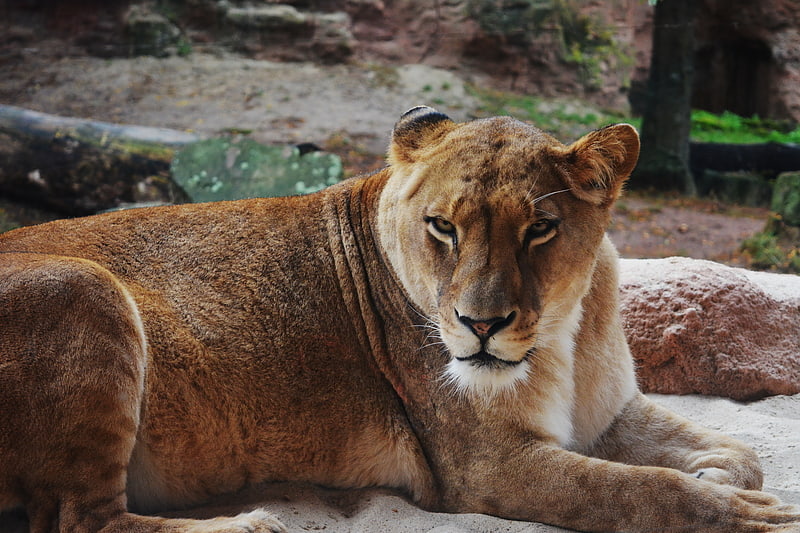
Also known as: Erlebnis-Zoo Hannover
Exotic animals in naturalistic habitats. Hanover Zoo is located in the city centre of Hanover, Germany. The zoo was established on 4 May 1865, and comprises an area of 22 hectares. It contains about 3,414 animals in 237 species, which are cared for by more than 400 employees in the summer season.[43]
Address: Adenauerallee 3, 30175 Hannover (Mitte)
St. Sebald, Nuremberg
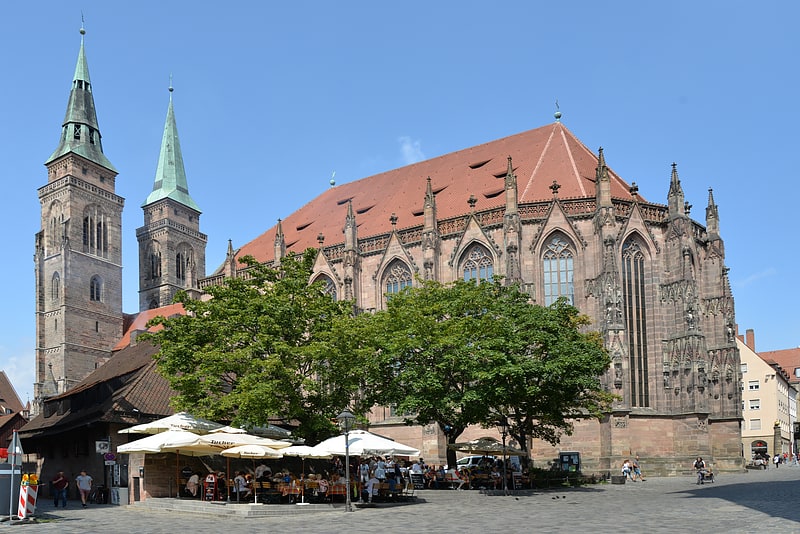
Medieval church with a large pipe organ. St. Sebaldus Church is a medieval church in Nuremberg, Germany. Along with Frauenkirche and St. Lorenz, it is one of the most important churches of the city, and also one of the oldest. It is located at the Albrecht-Dürer-Platz, in front of the old city hall. It takes its name from Sebaldus, an 8th-century hermit and missionary and patron saint of Nuremberg. It has been a Lutheran parish church since the Reformation.[44]
Address: Winklerstraße 26, 90403 Nürnberg (Mitte)
Völkerschlachtdenkmal, Leipzig
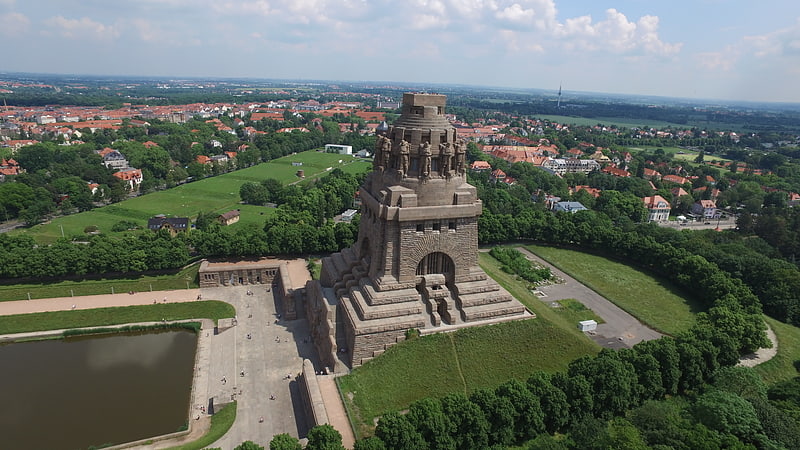
City views from a vast military memorial. The Monument to the Battle of the Nations is a monument in Leipzig, Germany, to the 1813 Battle of Leipzig, also known as the Battle of the Nations. Paid for mostly by donations and the city of Leipzig, it was completed in 1913 for the 100th anniversary of the battle at a cost of six million goldmarks.
The monument commemorates the defeat of Napoleon's French army at Leipzig, a crucial step towards the end of hostilities in the War of the Sixth Coalition. The coalition armies of Russia, Prussia, Austria and Sweden were led by Tsar Alexander I of Russia and Karl Philipp, Prince of Schwarzenberg. There were Germans fighting on both sides, as Napoleon's troops also included conscripted Germans from the left bank of the Rhine annexed by France, as well as troops from his German allies of the Confederation of the Rhine.
The structure is 91 metres (299 ft) tall. It contains over 500 steps to a viewing platform at the top, from which there are views across the city and environs. The structure makes extensive use of concrete, and the facings are of granite. It is widely regarded as one of the best examples of Wilhelmine architecture. The monument is said to stand on the spot of some of the bloodiest fighting, from where Napoleon ordered the retreat of his army. It was also the scene of fighting in World War II, when Nazi forces in Leipzig made their last stand against U.S. troops.[45]
Address: Strasse des 18. Oktober 100, 04299 Leipzig (Südost)
Speyer Cathedral, Speyer
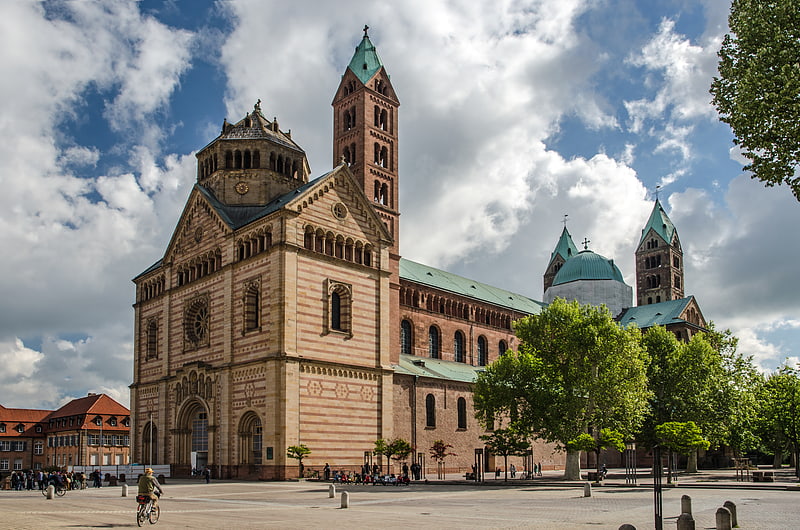
Also known as: Speyerer Dom
11th-century Romanesque cathedral. Speyer Cathedral, officially the Imperial Cathedral Basilica of the Assumption and St Stephen, in Latin: Domus sanctae Mariae Spirae in Speyer, Germany, is the seat of the Roman Catholic Bishop of Speyer and is suffragan to the Roman Catholic Archdiocese of Bamberg. The cathedral, which is dedicated to St. Mary, patron saint of Speyer and St. Stephen is generally known as the Kaiserdom zu Speyer. Pope Pius XI raised Speyer Cathedral to the rank of a minor basilica of the Roman Catholic Church in 1925.
Begun in 1030 under Konrad II, with the east end and high vault of 1090–1103, the imposing triple-aisled vaulted basilica of red sandstone is the "culmination of a design which was extremely influential in the subsequent development of Romanesque architecture during the 11th and 12th centuries". As the burial site for Salian, Staufer and Habsburg emperors and kings the cathedral is regarded as a symbol of imperial power. With the Abbey of Cluny in ruins, it remains the largest Romanesque church. It is considered to be "a turning point in European architecture", one of the most important architectural monuments of its time and one of the finest Romanesque monuments.
In 1981, the cathedral was added to the UNESCO World Heritage List of culturally important sites as "a major monument of Romanesque art in the German Empire".[46]
Address: Domplatz 1a, 67346 Speyer
St. Mary's Church, Lübeck
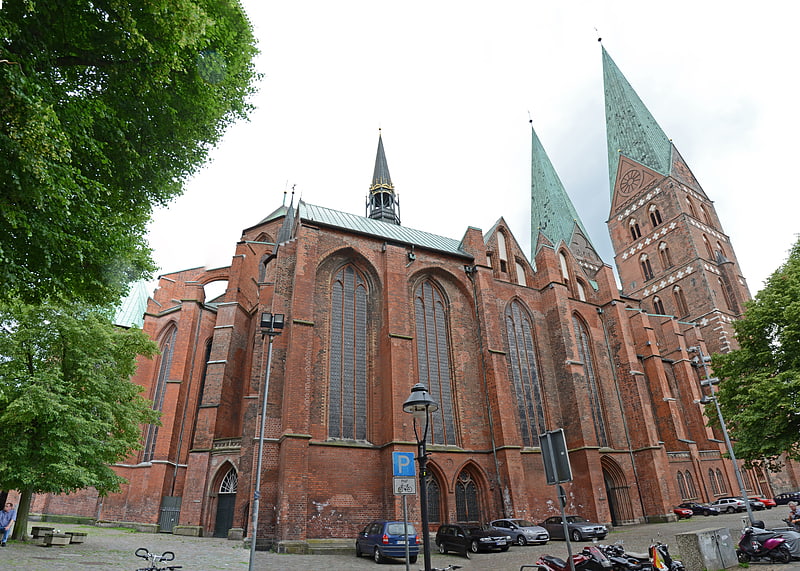
Also known as: Marienkirche
13th-century symbol of the city. The Lübeck Marienkirche was built between 1265 and 1351. The Lübeck market and main parish church is located on the highest point of Lübeck's old town island, is part of the Lübeck Old Town UNESCO World Heritage Site and one of the largest brick churches. It is referred to as the "mother church of brick Gothic" and is considered a major work of church building in the Baltic Sea region. St. Marien belongs to the Evangelical Lutheran Church in Northern Germany.
St. Mary's epitomizes north German Brick Gothic and set the standard for about 70 other churches in the Baltic region, making it a building of enormous architectural significance. St Mary's Church embodied the towering style of Gothic architecture style using north German brick. It has the tallest brick vault in the world, the height of the central nave being 38.5 metres (126 ft).
It is built as a three-aisled basilica with side chapels, an ambulatory with radiating chapels, and vestibules like the arms of a transept. The westwork has a monumental two-tower façade. The height of the towers, including the weather vanes, is 124.95 metres (409.9 ft) and 124.75 metres (409.3 ft), respectively.
St. Mary's is located in the Hanseatic merchants' quarter, which extends uphill from the warehouses on the River Trave to the church. As the main parish church of the citizens and the city council of Lübeck, it was built close to the town hall and the market.[47]
Address: Schüsselbuden 13, 23552 Lübeck
Zoo Heidelberg, Heidelberg
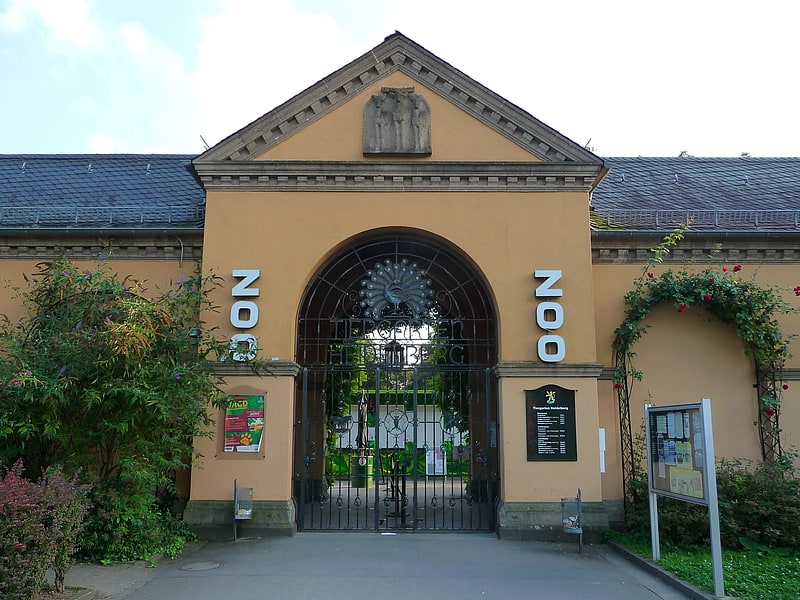
Zoo in Heidelberg, Germany. Heidelberg Zoo is a zoo in Germany which was founded in 1933 and opened for the public on 20 November 1934. Since 1998, the zoo director has been Klaus Wünnemann.[48]
Address: Tiergartenstr. 3, 69120 Heidelberg
Nuremberg Zoo, Nuremberg
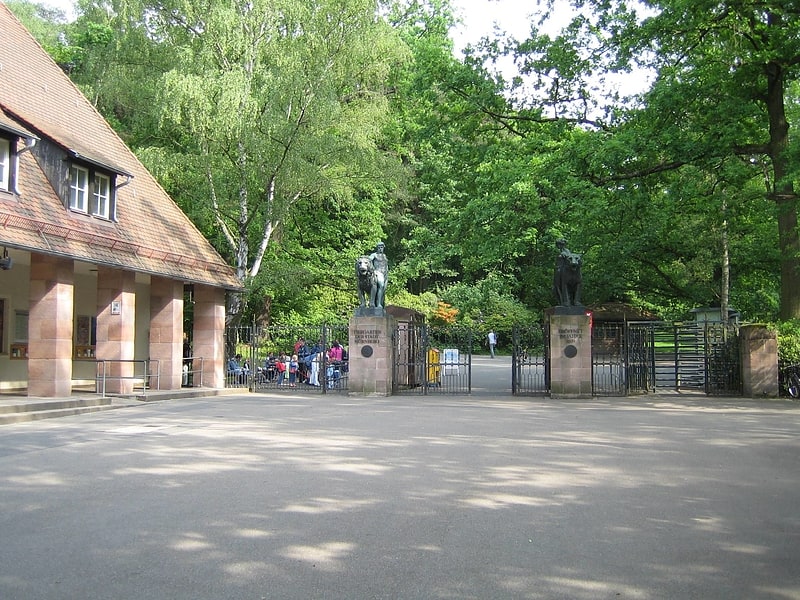
Also known as: Tiergarten Nürnberg
Zoo with woodland and exhibitions center. Nuremberg Zoo is a zoo located in the Nuremberg Reichswald, southeast of Nuremberg, Germany. With an area of 67 hectares, approximately 300 animal species are kept by the zoo.[49]
Address: Am Tiergarten 30, 90480 Nuremberg (Ost)
St. Nicholas Church, Leipzig
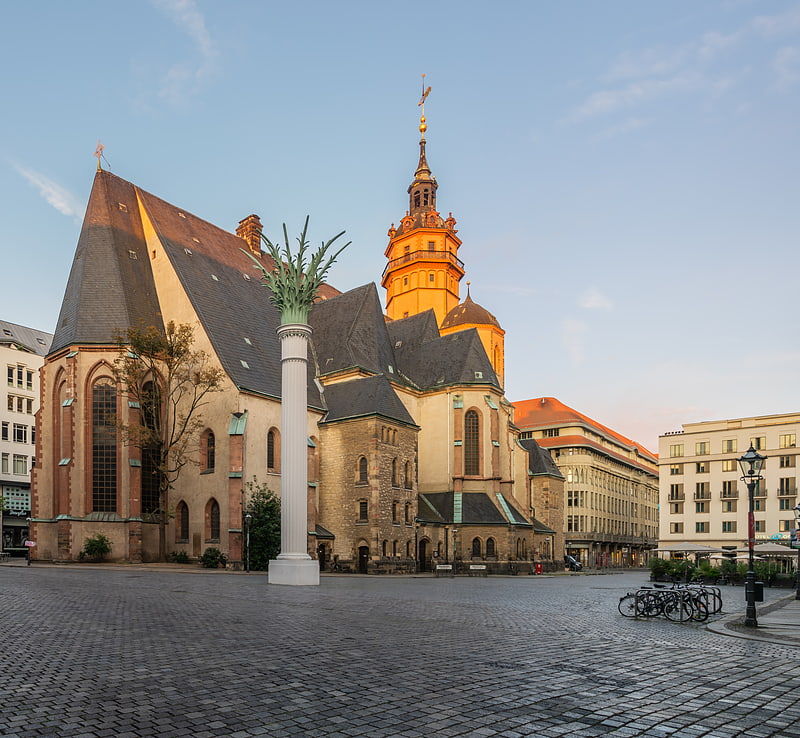
Also known as: Nikolaikirche
12th-century church in various styles. The St. Nicholas Church is one of the major churches of central Leipzig, Germany. Construction started in Romanesque style in 1165, but in the 16th century, the church was turned into a Gothic hall church. Baroque elements like the tower were added in the 18th century.
In the 18th century, several works by Johann Sebastian Bach, who was the music director of Nikolaikirche and of St. Thomas Church from 1723–50, premiered here. The Neoclassical interior dates to the late 18th century.
The church rose to national fame in 1989 with the Monday Demonstrations when it became the centre of peaceful revolt against communist rule. By capacity, it is one of the largest churches in Saxony.[50]
Address: Nikolaikirchhof 3, 04109 Leipzig (Mitte)